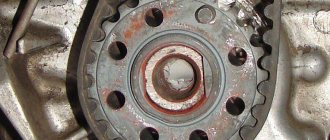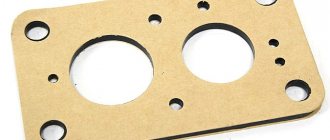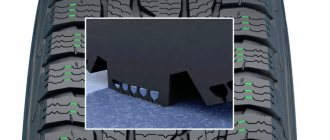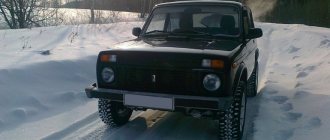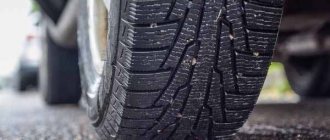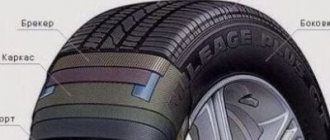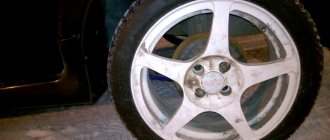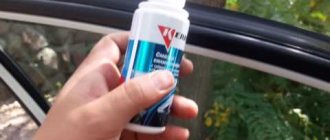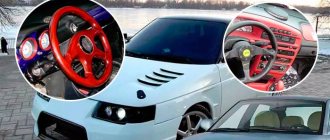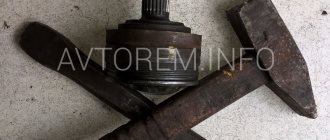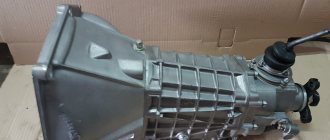Thanks to the wheels, the car has the ability to move along the road. They are supplied with rotation from the engine through the transmission, and due to frictional forces the wheels are pushed off the surface, and the car moves.
Car wheels consist of two components - a tire and a wheel. The main working element of the wheel is the tire, or otherwise the ramp, and the disk acts as a seat for it, and also provides fastening of the wheel to the hubs.
Tires provide:
- Road grip;
- Smoothing out minor road irregularities;
- Ability to move on surfaces with different characteristics;
- Car controllability.
Also, noise during movement depends on these elements.
Internal organization
The structure of a car tire is complex, despite its simple appearance. In cross section, the slope has a C-shape, which is formed by a number of layers.
One of the bus schemes
These layers have their own name:
- cord frame;
- breaker;
- tread.
Additionally, a substrate can be used between the last layers.
The cord carcass is the basis of the tire. The basis of the frame is cord - rubberized layers of threads (cotton, viscose, nylon, steel wire) covering the entire area of the frame and arranged in a certain way. The frame may consist of one or several cord layers.
Based on the arrangement of the carcass threads, tires are divided into diagonal and radial. In the first case, a cross arrangement of cord layers is used. In radial tires, the threads run perpendicular to the direction of rotation of the wheel. Diagonal tires are now practically not produced.
The breaker is another layer of cord, but it is not located over the entire area of the frame, but only on the working surface. In addition, the breaker uses stronger threads, which increases the strength and resistance of the frame to damage. In essence, the breaker acts as a reinforcing connecting layer between the frame and the tread. The breaker cord threads are positioned exclusively diagonally.
The tread is the outer working part of the tire. It is a fairly massive rubber layer made of high-quality materials and with a printed pattern formed by depressions in the rubber. This pattern is called the “treadmill”, which is in contact with the road. The tread not only provides the necessary grip on the surface, it also acts as a protective layer that protects the frame from damage. The type of pattern applied to the tread affects the traction qualities of the tire and divides them into road, universal, and all-terrain.
Manufacturing materials and their role
Automobile tires are produced from several components, which complement each other to ensure efficient operation of the tire. Also, the mixture in some sense affects the structure of the tire. Let's look at the composition of the tire in more detail. The following components are used for production.
- Rubber. Despite the diversity of the composition of modern rubber compounds, they are still based on different rubbers. At this point in time, artificial rubber is used, which is produced by synthesis from petroleum. Natural and synthetic isoprene rubber can also be used. But the latter are used to a limited extent, only to obtain certain characteristics.
- Carbon technical. More often it is called “soot”. It is a mandatory component of the tire. It is thanks to its presence that the tire acquires a black color. But the main benefit of this material is increasing the strength of the product.
- Silicic acid is an analogue of carbon black. But it does not completely replace it; it is often used in “green” tires as it has less impact on the environment. Limited use.
- Sulfur – used as a vulcanizer.
- Oils and resins. They influence the hardness of tires and also regulate the level of wear resistance.
- Vulcanization activators. Typically stearic acids or zinc oxide are used. They provoke vulcanization of rubber and also ensure the formation of an oxide polymer network.
These are the main components of the rubber compound. Here you also need to take into account that each manufacturer has its own recipes, differing in the ratio of substances.
There are also environmental components. They are used to a limited extent due to their high cost. This is usually corn starch, which is added to the tread compound. This allows for improved tire rolling.
External device
If we consider the structure of a car tire only from the outside, then it consists of:
- sides;
- sidewalls;
- shoulders;
- treadmill.
The beads ensure a secure fit of the tire on the rim. The rigidity of these elements is provided by power rings made of metal wire, fused into the frame around the circumference. When looking at the cross section of a tire, the beads are the peaks in a C-shape.
The sidewalls extend from the sides - the side parts of the frame, coated with an additional protective layer of rubber that prevents damage to the cord frame.
The shoulders provide the transition from the sidewalls to the treadmill. In addition, when deformed (when hitting an obstacle, entering a turn), the shoulders take part in providing traction with the road.
The treadmill, which is the main working surface, approaches the shoulders, so it has the most multi-layered structure.
In cross-section, the tire structure is as follows: there are two beads connected to two sidewalls, which go to the shoulders, and those go to the edges of one treadmill, which forms a C-shape.
Recommendations
It is desirable that all tires installed on a car are not only the same size and design, but also the same model and, if possible, the same manufacturer. Despite the external similarity of some tread patterns, each tire model has a set of properties unique to it. When installing tires with different, although very similar, patterns on different axles of a car (this is allowed by the Road Traffic Rules), the grip properties will inevitably differ, which can have a detrimental effect on handling in critical situations. In the case of forced installation of non-identical tires, the following combinations should be avoided if possible: low-profile “rubber” in front and high-profile tires in the rear; Studded tires are installed on the drive axle of a front-wheel drive car, and without studs on the rear; New tires are installed in front, completely worn tires in the rear, or vice versa, etc. The last two options are especially dangerous, since on wet or icy asphalt the grip of the rear tires on the road is significantly reduced, which can lead to skidding and an accident. All tires, even within the same type, vary in rubber chemical composition, internal structure and tread pattern. This is due to the fact that it is impossible to make an “ideal” tire that would ensure maximum performance of the car under all road conditions. Therefore, manufacturers produce tires: with a certain specialization, when one (or two) properties are most developed (usually to the slight detriment of others). For example, a tire for comfortable highway driving, while having low noise and good ride comfort, may not provide good stability and controllability at high speeds. Or the tire has an increased service life and provides reduced fuel consumption (compared to other models) due to low rolling resistance, but may not provide good comfort, stability and handling. As a rule, all major manufacturers (unfortunately, still mostly foreign) indicate in their advertising brochures what exactly the best properties a given tire model has. True, they are silent about what properties were “sacrificed”; with averaged, approximately identical in magnitude, properties to ensure acceptable implementation of vehicle characteristics in a wide range of road conditions. Therefore, before choosing tires, you need to determine what properties of tires, in addition to reliable grip, are most important to you - “sportiness”, comfort, efficiency, etc. conditions in which the vehicle will be operated for a longer period of time; maximum load capacity and speed, overall tire dimensions that must match the vehicle. When switching to another dimension, it is desirable that the outer diameter of the tire does not change, which can be calculated using the formula: D = 25.4d+2sh, where d is the wheel diameter (inches), s is the tire profile width (mm), h is the series tires (the ratio of the height of the tire profile to its width in %). Recommended replacement options are given in table. 5. It is necessary to take into account that operating tires at maximum speeds and loads significantly reduces their service life.
Classification
There are several criteria by which car tires are divided:
- Method of sealing the internal space;
- Seasonality of use;
- Tread type;
- Scope of use.
All these criteria are quite important and are taken into account when choosing tires.
Sealing method
Based on the sealing method, existing types of tires are divided into tubed and tubeless.
In chamber air, providing the necessary pressure inside, is pumped into a special rubber cylinder - a chamber. The main disadvantage of such wheels is the ease of damage, since even a minor puncture of the tube will lead to a flat tire. But on the other hand, bending of the disc rim under strong shock loads does not lead to flattening. On passenger cars, the chamber type is now used very rarely.
In tubeless tires, air is pumped into the space formed by the inner surface of the tire and the rim. They are less “sensitive” to punctures and can withstand up to 7-8 punctures (provided that the element that punctured the tire remains in it). But even a slight bend of the rim will cause the bead to “peel off” and the wheel will bleed air.
Seasonality of use
Based on the season of use, tires are divided into summer, winter and all-season. The differences between them come down to the material of manufacture (summer ones use hard rubber, and winter ones use soft rubber), the shape of the pattern and the tread depth. The all-season option is intermediate, and does not provide proper grip either in winter or summer. The optimal period for using such rubber is early spring and late autumn.
Tread type
According to the type of tread, the types of tires are road, all-terrain and universal. The first ones are designed for use on hard surfaces. All-terrain tires are characterized by a deep tread and pronounced lugs, providing excellent driving performance on rough terrain. Universal wheels are suitable for both on-road and off-road driving, but not very much, since they have lugs, but they are not very “powerful”.
Scope of use
Depending on the area of use, tires can be general purpose or sports. All types of general purpose tires have a certain profile height to width ratio, which provides the necessary volume for air injection.
Sports tires include low-profile tires, slicks and semi-slicks. Low-profile ones have a low sidewall height. But to ensure the required volume for air injection, the designers increased the width of the tires. As a result, the contact area of the treadmill has increased, so low-profile tires have improved traction. They are intended for driving only on hard surfaces. Due to the presence of a tread, their use on public roads is allowed.
Slicks are exclusively sports tires. Their feature is the complete absence of a tread pattern, which ensures maximum contact between the wheel and the road. They are used only on dry hard surfaces.
Semi-slicks differ from slicks by the presence of a small tread in the central part of the treadmill, but there is no pattern on the surface at the edges. Despite the existing tread, such tires cannot be used on general roads; they can only be driven on auto tracks.
The most common problem associated with tires during car operation is punctures, as a result of which the air from the wheel escapes and further operation is impossible.
This problem was partially solved with the advent of tubeless tires. As already indicated, they are able to withstand a certain number of punctures.
Flat technology
Attempts to solve this problem led to the emergence of so-called “puncture-free” tires, also known as Run Flat tires.
There are two run flat technologies used on cars. The first of them is strengthening the sidewalls. Due to the increase in the rigidity of the sidewalls, when air is released, the weight of the car begins to be supported by the sidewalls. Thanks to this technology, a wheel without air can travel up to 100 km at a relatively good speed of up to 80 km/h.
Run flat technology
The second technology is the use of a support ring. This ring, made of high-strength plastic or metal, is installed and fixed on the rim inside the tire. In the event of a tire puncture, when the air is released, the wheel begins to rest on the ring, which allows you to continue driving without possible damage to the disc. Despite the fact that the ring is made of hard materials, the noise when driving does not increase much, since there is always a layer of rubber between the road and the ring.
Run flat technology really solves the problem of punctures. But in the case of wheels that have reinforced sidewalls, they will not help if the sidewall is severely cut. But wheels with a support ring are expensive and require specialized equipment for maintenance.
It is worth noting that Run Flat is a general designation for puncture-free tire technology. Manufacturers often use their own designation for such rubber, which creates some confusion.
Additional tire marking parameters
- Winter - winter tires.
- A pictogram in the form of a snowflake - tires are marked for use in harsh winter conditions.
- Aqua, Rain, Water, Aquatred, Aquacontact, etc. (or umbrella pictogram) - indicates that the tires are effective on wet roads.
- AS, All Season or AGT (All Grip Traction) - designation of all-season tires
- AW or Any weather - all-weather
- M+S (Mud+Snow) or M&S - mud and snow, winter or all-season tires are specially designed to improve vehicle handling when driving in mud or snow (in slush, not to be confused with winter use - for this it is better to choose tires marked 3SMPF ( details below).
At the end of the marking there may be an “ E ” - studded tires.
- If the tire sidewall does not have the above-described markings, then this tire is intended for use only in summer conditions.
- All-Terrain is a designation for all-terrain tires with universal properties intended for SUVs.
- Max pressure — The maximum permissible pressure, measured in kPa.
- Max Load - The maximum permissible load on a tire, measured in kg (or British pounds).
- ROTATION with a directional arrow – applied to tires with a directional tread pattern, indicating the direction of rotation of the tire.
- FRT = Free Rolling Tire: This tire can only be installed on a trailer axle or free rolling axle and cannot be installed on a steering or drive axle.
- HCT = Hot Climate Technology: A tire with specific characteristics for working in countries with hot climates.
- DOT – compliance with US standards. The US Department of Transportation requires tire manufacturers to evaluate tire quality [Tire Quality Classification], with the exception of winter tires. This code identifies the company and factory, soil, batch, and production date (2 digits for the week of the year plus 2 digits for the year; or 2 digits for the week of the year plus 1 digit for the year for tires made before 2000).
- E in a circle - tires that meet ECE (Economic Commission for Europe) requirements are marked. The number indicates the country of approval.
- Reinforced (or the letters RF at the end of the size) - indicate that the tire is reinforced, used for vehicles with increased load capacity, and has 6 layers. The letter C in the size designates a truck tire with 8 layers.
- XL (Extra Load) – reinforced tire.
- Radial – tire of radial design. The same as the letter R in the standard size. Steel (steel belted) - this means that the tire structure contains a metal cord.
- Outside, Side Facing Out – the outer side of a tire with an asymmetric tread pattern. During installation, the word Outside must be on the outside of the machine.
- Inside, Side Facing Inwards - the inner side of the tire with an asymmetric tread pattern. During installation, the inscription Inside must be located on the inside of the machine.
- Retread - restored;
- Plies – tire design features – Tread area: – tread layer composition; Sidewall: – composition of the sidewall layer.
Tubeless or TL – marking of tubeless tires. The absence of this marking indicates that this tire can only be used with a tube. Tube Type, TT or MIT SCHLAUCH - the tire must be used only with a tube. Parameters reflecting the quality of tires, according to the American UTOG tire quality classification system: Traction A, B or C - the coefficient of adhesion to the road surface or the tire’s braking ability. Takes on the values A, B, C. Coefficient A means the highest value of adhesion in its class. Temperature A, B or C is an indicator characterizing the heat resistance of the tire. Possible values are A, B and C. Indicator A is the best Treadwear 200 - wear resistance coefficient, determined in relation to the base tire (it has a value of 100) of a particular manufacturer. Obtained as a result of standardized tests in the USA. TWI (tread wear index) or TWID - indicates the location of the projector wear indicators, protrusions at the bottom of the tread grooves. When the tread wears down to the level of these indicators, the tire is considered unsafe to operate and it is time to replace it. Date of manufacture of the tire (four digits, enclosed in an oval or rectangle with rounded corners) - the first two digits indicate the serial number of the week in the year, the next two the year of manufacture. DA (stamp) - minor manufacturing defects that do not interfere with normal operation are indicated. The tire also indicates: • Trademark, manufacturer's name • Trademark (tire model). • Made in... – name of the country of the tire manufacturer. FB – (Flat Base) – marking of tires without rim protection. FR – (Flange pRotector) – marking of tires with rim protection. Green X, Reduces CO2 - designations for tires with low rolling resistance, indicate fuel savings due to the use of such tires. RunFlat, RunOnFlat, HP, SSR, SST - designations indicating that these are emergency tires, making it possible to continue driving even when the tire is flat. RPB (Rim Protection Bar) or MFS – (Maximum Flange Sheild) – protects the rim from damage from curbs and sidewalks.
"Self-healing tires"
But there is another technology for “puncture-free” tires – “self-healing”. It does not apply to Run Flat.
The essence of this technique comes down to applying a special viscous material to the inner surface of the tire. In the event of a puncture, it clogs the resulting hole and prevents air from escaping. This technology is the simplest and at the same time the cheapest. The cost of tires with such an internal coating is practically no different from regular tubeless tires.
By the way, on the car accessories market you can now find special compounds that make it possible to make “self-healing” tubes out of ordinary tubeless ones. And to do this, it is enough to pump the compound inside the wheel through the valve, and during operation, the filled material spreads evenly over the inner surface of the tire, the disadvantage of this method is that the entire inner surface of the disk will be covered with this compound.
General information
Tires can be tubed or tubeless in design, and radial and diagonal in design. Depending on the purpose and operating conditions, tires are divided into: road
(commonly called summer) are intended for use at positive temperatures on highways.
Tires of this type provide the best grip on dry and wet roads, have maximum wear resistance and are best suited for high-speed driving. They are of little use for driving on dirt roads (especially wet ones) and in winter. winter,
used on icy and snowy roads, the adhesion qualities of which can vary depending on the situation, from minimal (smooth ice or a mess of snow and water) to small (rolled snow in the cold).
They have good road properties, somewhat inferior to summer tires. Many winter tires allow or have anti-skid studs. All-season tires are
They allow you to operate your car year-round on one set of tires.
universal ones have
It is advisable to use them for all-terrain vehicles that make approximately equal mileage on highways and roads.
It can be quite difficult to draw a clear line between them and all-season tires. all-terrain vehicles are designed
It is advisable to use such tires only when driving rarely on the highway. Otherwise, they will wear out faster and create high noise levels.
